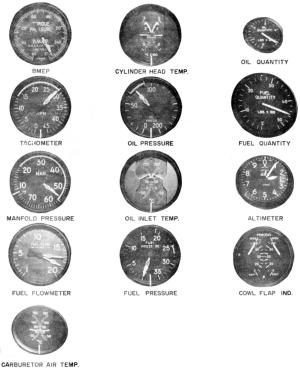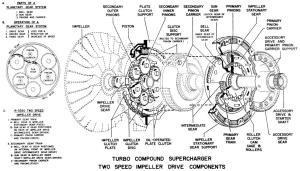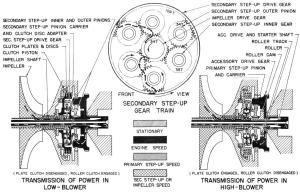
Blower Drive Failures in Wright Turbo Compound Engines
by Carl Kuhns

|
| Curtiss-Wright R-3350 Turbo Compound on Delta DC-7C |
The Douglas DC-7C was the last in a series of successful multi-engine piston-powered transport aircraft. It and later models of the Lockheed Constellation, both powered by Wright R-3350 Turbo Compound engines, pioneered many long-distance commercial passenger flights. The long range of these two aircraft was made possible in part by the Turbo Compound’s excellent cruise BSFC (brake specific fuel consumption) of 0.40 lb/hp/hr. Sometimes these engines suffered internal failures that led to emergency landings or even crashes.
I would like to detail the sequence of events that led up to the loss of a propeller and the emergency landing of a Scandinavian Airlines DC-7C in the Fall of 1957, and two similar incidents with the same aircraft and engine type.
My major source of information for this article is a series of historical aircraft accident reports available online from the US Department of Transportation (http://dotlibrary.specialcollection.net/). Other sources are listed at the end of this article.
 |
| Turbo Compound Engine Instruments |
On October 29, 1957, a Scandinavian Airlines Douglas DC-7C, registration number OY-KNB (OY is the registration code for Denmark), departed Idlewild Airport (now JFK) in New York City on a 3,300-nautical-mile direct flight to Copenhagen, Denmark (Accident Report, 436K PDF). The aircraft’s take-off weight was 138,000 pounds and its fuel load was 7,000 gallons. The craft reached its cruising altitude of 21,000 feet in about an hour. Two hours into the flight, trouble began when engine roughness developed. Engine instruments showed the problem was with Number 1 engine. The BMEP (Brake Mean Effective Pressure) is an average measure of power developed in a cylinder. No. 1 BMEP dropped to zero, manifold pressure dropped to 20-25 inches, the oil temperature increased and the oil pressure dropped. Before the crew could feather the 13’ 11"-diameter, 4-blade Hamilton Standard model 34E60 Hydromatic propeller, it oversped, and further efforts to feather it were unsuccessful. The propeller continued to windmill as sparks and flames appeared around No. 1 engine. At this point, an emergency was declared and a return to Boston Airport was requested and granted at a reduced airspeed of 140 knots.
The propeller continued to windmill and three hours after the first hint of trouble, it separated from the engine and fell into the sea without striking the aircraft.
Twenty minutes after the loss of the propeller, the aircraft made a successful landing at Boston’s Logan Airport, with no injuries to the crew or passengers.
Total time on the 18-cylinder Wright R-3350 model 988TC18EA-1 radial was 1,514 hours with a time since overhaul of 664 hours. Engine inspection showed major damage to most parts of the engine. The propeller shaft was broken. The propeller governor contained metal particles and was stuck in the “on speed condition.” All of the link rods and master rods were broken. All main bearings were damaged. The rear counterweight was jammed against the rear crankcase.
"The initial failure was believed to have been the fatigue fracture of the number 1 engine impeller intermediate drive gear CPN (145316N)". A laboratory analysis revealed that the failure of the impeller intermediate drive gear was caused by fatigue fractures. "The propeller malfunction resulted from contamination by fine metal particles which were generated and introduced into the oil supply by the gear failure." The overspeed and inability to feather the propeller were caused by the governor pilot valve seizing in the "on speed" position. It is believed that the propeller separated from its shaft when the rear crankshaft counterweight jammed against the crankcase and seized the engine. As a result of this accident an airworthiness directive (AD-57-24-1) was issued, which required replacement of intermediate drive gear (P/N 145316N) with part number 138464 at the next overhaul or not later than July 31, 1958.
The Hamilton Standard Hydromatic propeller used the engine oil supply, boosted in pressure by the propeller governor, to control the pitch of the propeller blades. In contrast, Curtiss Electric propellers used on some of the Wright TC18 powered Lockheed Constellations used an electric actuation system that did not rely on engine oil for operation.
DC-7C OY-KNB was repaired and was in service until broken up for scrap in 1967. The nose section was preserved and is displayed in the Danish National Museum of Science and Technology.
 |
 |
| Turbo Compound Two-SpeedImpeller Drive | Turbo Compound Two-SpeedImpeller Drive |
My research also turned up two other very similar failures in Wright 988TCEA-1 engines.
On July 14, 1960, a Northwest Airlines DC-7C ditched in the Pacific Ocean 67 nautical miles from the Manila Philippines Airport with only one fatality (Accident Report, 577K PDF).
As the aircraft was approaching Manila after a flight from Okinawa, the #2 engine experienced a loss of power, followed by overspeeding of the propeller. The crew was unable to feather the propeller and it soon separated from its shaft with a resulting nose case fire. The rain showers in the area increased the intensity of the magnesium fire in the engine. The uncontrollable fire in #2 engine nacelle raised concerns with the structural integrity of the wing and prompted the decision to ditch the aircraft.
As it was not physically possible to examine the failed engine, the Safety Board had to rely on the flight crew’s testimony. Based on the testimony of the flight crew, it was concluded that the initial failure occurred to components in the two-speed supercharger impeller drive system.
On October 22, 1962, another Northwest DC-7C was successfully ditched in Sitka Sound, Alaska with no serious injuries reported (Accident Report, 451K PDF). The aircraft was cruising at 14,000 feet and began to encounter both airframe and engine induction icing. Use of carburetor alcohol proved effective in dealing with engine icing. In an effort to climb to an ice-free altitude, the engines were placed in high blower and maximum except takeoff (METO) power was used, 2,600 rpm and 47 inches of manifold pressure. After reaching 20,000 feet, number 2 engine BMEP fell from 172 to 80, then to 50. About 30-60 seconds after the power loss, the number 2 propeller began to overspeed and the engine RPM soon reached 3,400. Efforts to feather the Hydromatic propeller exhausted not only the engine oil supply, but also oil transferred from the auxiliary tank. The propeller continued to rotate and the decision was made to ditch the aircraft.
Although there was no engine available to examine, the Safety Board believed that the initial failure was to the components in the two-speed supercharger assembly.
If the supercharger impeller stops being driven due to a failure of its drive components, the supercharging effect is lost and the engine stops producing power. Now the slipstream is turning the propeller. Engine oil with metal contamination from the failed impeller drive is now being circulated through the engine at approximately 50 gallons per minute. This contaminated oil then damages internal parts of the engine. Since a Hydromatic propeller governor uses engine oil for its operation, it would also be damaged and the propeller could not be feathered. Catastrophic engine damage can result in an engine fire. If a fire results and it cannot be extinguished with the fire extinguishers located in the engine nacelle, the aircraft’s wing can sustain structural damage.
It seems Wright Aeronautical Division (W.A.D.) struggled for years to remedy blower drive problems. AD 57-24-1 appears to be a case of an improved part having to be replaced by an older part, maybe due to a manufacturing defect. Reducing the engine speed to 1,600 rpm before shifting the blower was one recommendation to ease the strain on the impeller drive train. The airlines pressed for a more permanent solution. Reducing engine rpm before a shift to high blower results in a rate of climb reduction. W.A.D. tried other solutions, namely wider outer drive pinions, a new coarse tooth gear train, single piece bushings, and a thicker intermediate drive gear.
Fortunately, most impeller drive problems did not result in catastrophic engine failures. A September 1960 report issued by Wright Aeronautical Division lists causes of premature engine removals. From January through July 1960, there were 139 premature engine removals due to impeller drive problems, compared to 298 premature engine removals due to combustion chamber problems.
I would like to thank Tom Fey for his suggestions and help with editing my draft.
http://www.brugkulturen.dk/index.php?id=300
http://en.wikipedia.org/wiki/Douglas_DC-7
http://rgl.faa.gov/Regulatory_and_Guidance_Library/rgMakeModel.nsf/0/06cfb98281570eb4852567290052f064/$FILE/4a10.PDF
Engine Premature Removals, report by Robert E. Johnson, Assistant to the General Manager, Wright Aeronautical Division (W. A. D.) 9/23/60
Major Engine Difficulties, W.A.D. Confidential Report, Number 75, 3/12/56
Summary minutes of the operations meeting conducted by the Field Engineering Department at W.A.D., 1955
Details of Design Features of the 3,400 HP 988 TC18EA Series Engines, W.A.D. brochure, 12/19/55
Curtiss-Wright R-3350-TC18DA
Turbo Compound Specifications
Courtesy of Robert S. Wahlgren
| Number of Cylinders | 18 | |
| Bore | 6.125" | |
| Stroke | 6.312" | |
| Displacement | 3,350 in³ | |
| Compression Ratio | 6.7:1 | |
| Supercharger Ratio | 6.46:1, 8.67:1 | |
| Impeller Diameter | 13.5" | |
| Crankshaft Rotation fromRear | Clockwise | |
| Propeller Shaft Rotationfrom Rear | Clockwise | |
| Spline | SAE No. 60 | |
| Engine Diameter | 56.59" | |
| Overall Length | 98.53" | |
| Total Dry Weight ± 1% | 3,484 lb | |
| Valve Timing | ||
| Intake Opens | Front 45°BTC, Rear 55° BTC | |
| Intake Closes | Front 56° ABC, Rear 56°ABC | |
| Exhaust Opens | Front 70°BBC, Rear 70° BBC | |
| Exhaust Closes | Front 45° ATC, Rear 55°ATC | |
| Intake Duration | Front 281°, Rear 291° | |
| Exhaust Duration | Front 295°, Rear 305° | |
| Overlap | Front 90°, Rear 110° | |
| Valve Clearance | Timing check 0.055" For valve adjustment 0.010" | |
| Ignition System | ||
| Type | Low tension | |
| Magneto and DistributorTiming @ cylinder #1) | 25° BTC | |
| Magneto | Scintilla DLN-9 | |
| Spark Advance | 25° BTC | |
| Spark Plugs and Gap | AC 285 0.011" - 0.014" Champion R-103 0.015" - 0.018" | |
| Fuel System | ||
| Type | Direct Fuel Injection | |
| Master Control | Bendix PR-58-S-2 | |
| Fuel Injection Timing (Established on Cylinder #1) | 25° BTC | |
| Maximum Cylinder Head Temperature | 500° F | |
Facts About the Wright Turbo Compound (3.0 MB PDF)
Description of Wright R-3350 Turbo Compound Direct Fuel Injection and Exhaust System (1.1MB PDF)
 |
| Power Recovery Turbine Wheel From AirVenture Museum, 2001 |